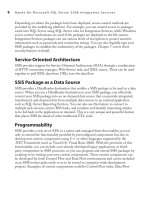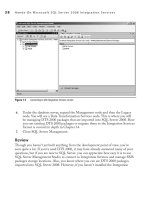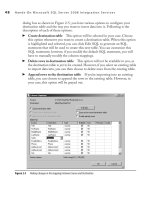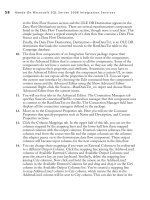Hands-On Microsoft SQL Server 2008 Integration Services part 33 pot
Bạn đang xem bản rút gọn của tài liệu. Xem và tải ngay bản đầy đủ của tài liệu tại đây (449.25 KB, 10 trang )
298 Hands-On Microsoft SQL Server 2008 Integration Services
13. Expand the Iterating October Opportunities container and select the Mailing
Opportunities task. Note that the events on the Details tab remain the same, as
the logging options have been inherited from the parent. Click twice on the check
box to the left of Mailing Opportunities to place a highlighted tick in the check
box and change the LoggingMode to Enabled for this task. As you do that, you
will notice that three new events—SendMailTaskBegin, SendMailTaskEnd,
and SendMailTaskInfo—have been added to the list in the Details pane. These
are the custom log entries provided by the SMTP task, as you know many of
the Integration Services objects provide custom log entries for logging specific
information related to their functionality only.
14. Click Advanced and you will see the information fields that will be logged when
the selected events occur. These log schema fields have been described earlier in
this chapter. Select the OnProgress, SendMailTaskBegin, SendMailTaskEnd,
and SendMailTaskInfo events only, as shown in Figure 8-3. Note that all the
fields of log schema are selected by default.
15. Go to Providers and Logs tab. Select the check box for SMTP task level log to
Text file, as you want to log events to a text file for Mailing Opportunities Task.
Click OK to close the Configure SSIS Logs dialog box. You’ve successfully
configured logging for this package.
Figure 8-2 Enabling events to log
Chapter 8: Advanced Features of Integration Services 299
Exercise (Analyze Integration Services Logs)
Finally, let us execute the package to record logs entries and check them using SQL
Server Management Studio.
16. Press the 5 key to execute the package. You will see the components changing
color from yellow to green. When the package execution completes, press -
5
to return to design mode.
17. Run SQL Server Management Studio and connect to the database engine. Run
the following query in the Query pane:
Select * from [Campaign].[dbo].[sysssislog]
Look through the results and particularly note the OnPreExecute event and the
OnPostExecute event of Iterating October Opportunities. Note the start time
and end time of these events.
18. Explore to the C:\SSIS\Projects\Contacting Opportunities with Logging folder
and open the SMTPTaskLevel.log file using Notepad. Scroll right to the end of
file and note that the Send Mail task has been initiated and completed seven times,
corresponding to the seven messages it sent out. These events occurred in between
the start time and end time of the Iterating October Opportunities container.
Figure 8-3 Configuring unique log entries for the Mailing Opportunities task
300 Hands-On Microsoft SQL Server 2008 Integration Services
Review
You’ve enabled and configured logging options in this exercise with unique logging
options on the Mailing Opportunities task. You’ve seen how the inherited logging
options work and that you do not need to set any configurations. However, if you need
to save disk space and tighten up logging only for the required events, you can do so by
configuring unique log entries as you have done with the Mailing Opportunities task.
One interesting thing to note is that the events such as OnError and OnWarning, not
captured at the task level, do not get lost; instead, they travel up and can be captured at
container level. This means that you do not need to log everything at every component
level. You can actually choose discrete levels in the package where you want to capture
errors and warnings. This will maintain high levels of performance and keep the disks
free of unwanted logs. From the best practice point of view, you should be logging
heavily during development and debugging phases while reducing the logging to
the minimum required level at normal production runs. Some developers log to the
Windows Event log in the development environment, as this is very simple to set up
and they won’t have to manage log files or clear up any files.
Transactions in Integration Services Packages
Transactions enable you to implement data integrity and consistency within your
packages. In DBMS world, a transaction is considered an atomic piece of work that must
be completed entirely or rolled back altogether. Sometimes it becomes imperative to use
transactions when working with database systems. For example, in banking systems,
when somebody transfers money from his account to someone else’s account, the money
has to be debited and credited in a single transaction—either both operations of debiting
and crediting will happen or both will be rolled back if the system is unable to complete
the transaction at any stage while processing this transaction. In this way, you can
be sure that the data integrity will be maintained. Transactions are required to possess
the ACID properties (Atomicity, Consistency, Isolation, and Durability), without which
the integrity of the transacted data cannot be guaranteed. Integration Services also allows
you to use transactions within a package or among one or more packages.
Containers within an Integration Services package can be configured to use transactions
by setting the TransactionOption property to Required or Supported in the Transactions
section of the container’s Properties window. As the tasks are enclosed within the
task host containers, the tasks can also be configured to use transactions using the
TransactionOption property. This property can have one of three possible values:
Required
c e container must participate in a transaction when the
TransactionOption is set to Required. at is, if the parent of this container
has already started a transaction, this container will join that transaction; if no
transaction exists, this container will start a new transaction.
Chapter 8: Advanced Features of Integration Services 301
Supported c e container will participate in a transaction if it already exists
when the TransactionOption is set to Supported. However, if a transaction doesn’t
exist, it will not start a new transaction.
NotSupported
c e container will not participate in a transaction even if
a transaction exists. at is, the containers having TransactionOption set as
NotSupported will neither start a transaction nor join an existing transaction.
You can use transactions with various types of possibilities and scenarios. Because
Integration Services tasks support programming SQL Server, you can effectively use
native transactions supported by SQL Server. But for most of the work, you will be
using the Microsoft Distributed Transaction Coordinator (MSDTC) to support
transactions in Integration Services. MSDTC is a Windows service that provides
a transaction infrastructure across multiple computer systems or distributed computing
environments.
You can configure transactions involving tasks in a container, you can involve
multiple containers in a transaction, or you can have a transaction spanning over
multiple packages. These packages can be running on different machines, effectively
resulting in a transaction running in a distributed environment. Multiple transactions
can be included in a package, and multiple packages can be run under one transaction.
How package transactions are run depend on you how you configure transactions
on the containers and subcontainers and how you configure transactions when the
package is run as a child package under the context of an Execute Package task.
When a package is run under the context of an Execute Package task, it can inherit
the transaction started by the parent package if the Execute Package task and the
package are configured to join this transaction. In addition, while configuring multiple
transactions within a package, you may have a transaction running a transaction. These
nested transactions go hand in hand with the container hierarchy within a package.
However, issues arise when you use nested transactions that are not related—i.e., they
do not fall particularly within a single parent transaction, a condition that can cause
tasks not to roll back completely as desired. While configuring transactions within your
package, try to keep child transactions within the scope of a single parent transaction
and, as a best practice, test thoroughly before deploying to production.
Hands-On: Maintaining Data Integrity with Transactions
You are tasked with making sure that the data is always kept in consistent state,
irrespective of the data sources from which the data is coming. You are trying to
identify how the data could become inconsistent; you determined that one of the
reasons could be the data import process, when part of a record could not be imported.
Various packages and processes are importing data and you want to determine exactly
how transactions can protect your data.
302 Hands-On Microsoft SQL Server 2008 Integration Services
Method
In this exercise, you will be simulating various scenarios of data import and will work
with transaction options to maintain data integrity. You can configure transactions
within a package in various ways, but to help understand how they work, you will deal
with three main cases in which transactions can be used. The main steps involved in
this exercise are as follows:
Create a package and understand how data consistency can be affected with
c
loading operations.
Case I covers use of transaction involving multiple tasks but in a single container.
c
Case II covers transactions spanning multiple containers. c
Case III covers transactions spanning multiple packages. c
Exercise (Create a Simulation Package
for Data Consistency Issues)
You begin this exercise by creating NewCustomer, EmailAddress, and Vehicle tables
using SQL Server Management Studio. Then you move on to BIDS and create a new
Integration Services project to simulate data consistency issues.
1. Open SQL Server Management Studio, connect to the database engine, and run
the following queries to create three tables after opening a new query pane:
USE [Campaign]
GO
CREATE TABLE [dbo].[NewCustomer](
[CustomerID] [varchar](10) NOT NULL,
[FirstName] [varchar](50) NULL,
[SurName] [varchar](50) NULL
) ON [PRIMARY]
Go
CREATE TABLE [dbo].[EmailAddress](
[CustomerID] [varchar](10) NOT NULL,
[Email] [varchar](100) NOT NULL,
[Type] [varchar](50) NULL
) ON [PRIMARY]
Go
CREATE TABLE [dbo].[Vehicle](
[CustomerID] [varchar](10) NULL,
[VIN] [varchar](20) NOT NULL,
[Series] [varchar](50) NULL,
[Model] [varchar](50) NULL
) ON [PRIMARY]
GO
Chapter 8: Advanced Features of Integration Services 303
2. Open BIDS and create a new Integration Services project with the following
details:
Name Maintaining data Integrity with Transactions
Location C:\SSIS\Projects
3. When the new package loads up, right-click in the Connection Managers area
and choose New OLE DB Connection. In the Configure OLE DB Connection
Manager dialog box, choose localhost.Campaign and click OK. You’ve added
a connection manager to connect to the Campaign database.
4. Drop an Execute SQL Task from the Toolbox onto the Control Flow surface.
Rename this task as Loading NewCustomer.
5. Open the Execute SQL Task Editor by double-clicking its icon. In the Connection
field’s drop-down list, choose localhost.Campaign.
6. With SQLSourceType set to Direct Input, click in the SQLStatement field, and
then click the ellipsis button that appears in the right corner of the field to open
the Enter SQL Query dialog box. Type the following SQL statement in this
dialog box.
INSERT INTO NewCustomer (CustomerID, FirstName, SurName)
VALUES ('N501', 'Will', 'Harrison')
Click OK twice to close the Editor.
7. Repeat Steps 4 to 6 to add a second Execute SQL task to your package. Rename
this task Loading EmailAddress and edit it to add the localhost.Campaign
connection manager. Close the task after assigning the following SQL statement
to it:
INSERT INTO EmailAddress (CustomerID, Email, Type) VALUES
('N501', '', 'Work')
Join the Loading NewCustomer task with this task using an on-success
precedence constraint.
8. Repeat steps 4 to 6 to add a third Execute SQL task to your package. Rename
this task Loading Vehicle and edit it to add the localhost.Campaign connection
manager. Close the task after assigning the following SQL statement to it:
INSERT INTO Vehicle (CustomerID, VIN, Series, Model) VALUES
('N501', 'UV123WX456YZ789', 'X11 Series', 'Saloon')
Join the Loading EmailAddress task with this third task using an on-success
precedence constraint. Your package should look like the one shown in Figure 8-4.
9. Execute this package by pressing the 5 key. When all the tasks have changed
to green and the package has completed execution, press -
5 to return to
design mode.
304 Hands-On Microsoft SQL Server 2008 Integration Services
10. Switch to the SQL Server Management Studio and run the following query:
SELECT n.[CustomerID], [FirstName], [SurName], [Email],
[Type], [VIN], [Series], [Model]
FROM [Campaign].[dbo].[NewCustomer] n LEFT OUTER JOIN
[Campaign].[dbo].[EmailAddress] e
ON n.CustomerID = e.CustomerID
LEFT OUTER JOIN [Campaign].[dbo].[Vehicle] v
ON n.CustomerID = v.CustomerID
You will see the result contains customer details, the customer’s e-mail address,
and the vehicle details, all as you wanted (see Figure 8-5), irrespective to the fact
that the data is stored in different tables.
11. Note the TransactionOption property of the package in Figure 8-4, which is set
at the default value of Supported. This property has a Supported value for all the
three tasks as well. Only the containers with TransactionOption set as Required
can start a transaction, so no container started a transaction while this package
was executed. So far, so good. Now, let’s see what happens if a task fails and
doesn’t import a particular row.
Figure 8-4 Creating a simulation package for data consistency checks
Chapter 8: Advanced Features of Integration Services 305
Data uploading can fail for a particular record for various reasons. The most
common is a data type mismatch or a constraint on the column. If you go to the
Campaign database, expand the Vehicle table, and then look in the Columns
node in the Object Explorer in SQL Server Management Studio, you will see the
column properties of the Vehicle table. Note that the VIN field is a mandatory
(not null) field and must have a known value. If no data is received for this field
during the import process, that row will not be inserted.
12. Before you proceed, let’s clean up our tables. Run the following queries in the
Query pane to delete all the data from the existing tables:
DELETE [Campaign].[dbo].[NewCustomer]
DELETE [Campaign].[dbo].[EmailAddress]
DELETE [Campaign].[dbo].[Vehicle]
13. Switch to BIDS and modify the SQL statement in the Loading Vehicle task by
removing the VIN information from the SQL statement; your statement should
look as follows:
INSERT INTO Vehicle (CustomerID, Series, Model) VALUES
('N501', 'X11 Series', 'Saloon')
14. After you’ve made the change, press 5 to execute the package again. Keep in
mind that you’ve still not implemented a transaction in the package. This time,
you will see that the first two tasks execute successfully while the Loading Vehicle
task fails and turns red. Stop debugging the package.
Figure 8-5 The data consistency you want to see in your database
306 Hands-On Microsoft SQL Server 2008 Integration Services
15. Switch to SQL Server Management Studio and execute the query written in
Step 10 to see the results this time. You will see that the three fields—VIN,
Series, and Model—have NULL values. You have discovered how your data can
become inconsistent during the loading process.
16. Run the delete SQL statements written in Step 12 to cleanse this data from all
the tables.
Exercise (Case I: Avoiding Inconsistency in a Single Container)
In real life, you either commit all the data from all the tasks in the tables or roll back
the failing rows and throw those rows out and deal with them separately. In the
following steps, you will see how you can roll back the data by using transactions.
17. Click anywhere on the blank surface of the Control Flow panel and press 4 to
open the Properties window. Scroll down the Properties window and locate the
Transactions section. Change the TransactionOption value from Supported to
Required.
18. Press 5 to execute the package. You will again see that the first two tasks
complete successfully whereas the Loading Vehicle task fails as expected. Stop
debugging the package.
19. Switch to SQL Server Management Studio and execute the query written in
Step 10 in the preceding sequence to see the results. This time, you will see
no data at all in the output query. Setting the TransactionOption to Required
resulted in the use of a transaction under which all the three tasks were executed.
As the third task failed, the data loaded by first two tasks was rolled back.
Exercise (Case II: Transaction Spanning over Multiple Containers)
The preceding exercise demonstrated how you can use a transaction to avoid inconsistency
in data during loading operation. This was quite simple, involving only one container in
the package. What if a data-loading package uses multiple containers? Let’s see how that
can be handled.
20. Drop two Sequence Containers on the Control Flow surface from the Toolbox.
Delete the precedence constraint connecting Loading EmailAddress with
Loading Vehicle.
21. Select Loading NewCustomer and Loading EmailAddress along with the
precedence constraint either by using the mouse or by pressing and holding the
key on the keyboard while clicking the tasks one by one. With these tasks
selected, drag and drop them inside the first Sequence container.
Chapter 8: Advanced Features of Integration Services 307
22. Drag and drop the Loading Vehicle task inside Sequence Container 1. Drag the
green arrow from the Sequence Container and drop it on Sequence Container 1
to join these containers so that the tables are loaded in sequence. (Note that this
step is not required for running of the package, though.) Your package will look
like the one shown in Figure 8-6.
23. Your package is now using two sequence containers to load the data. Verify that
the two new containers have their TransactionOption set to default value of
Supported and the Package container’s TransactionOption property still has the
Required value set previously.
24. Press 5 to run the package. You will see that the first container with the two
tasks in it successfully executes and turns green. However, the second sequence
container with the Loading Vehicle task in it fails and turns red. Press -
5
to switch back to design mode.
25. Switch to SQL Server Management Studio and run the SQL statement you
wrote in Step 10 of the preceding sequence to see what’s been loaded in the
database. You will see that no data for the NewCustomer and EmailAddress
tables has been added, even though the loading tasks were successful. This is
Figure 8-6 Package consisting of multiple containers









